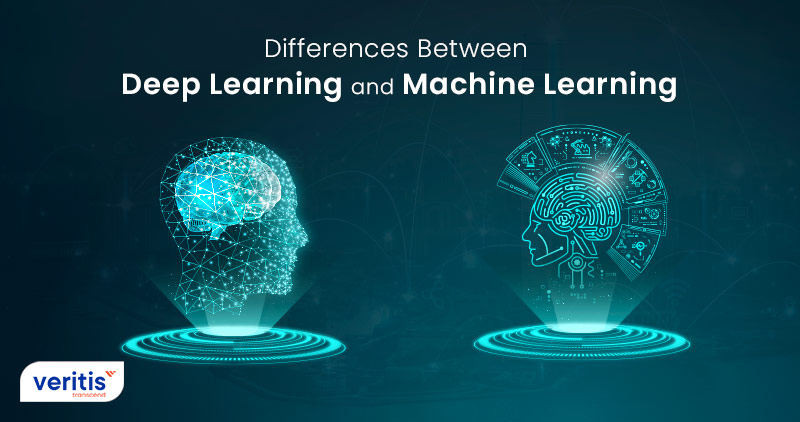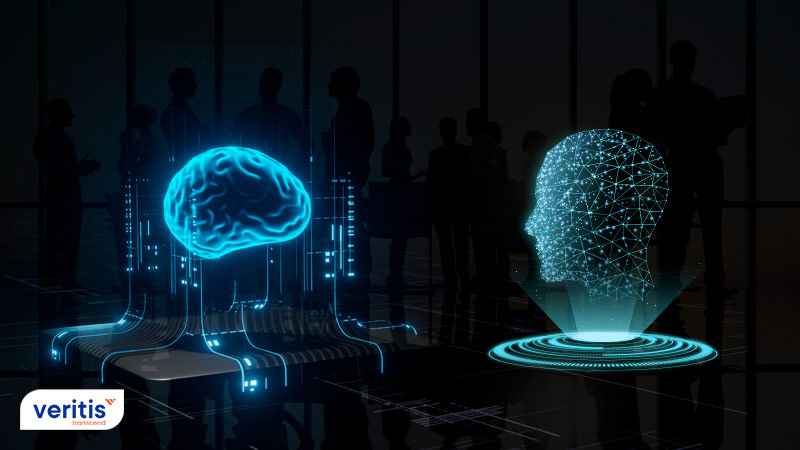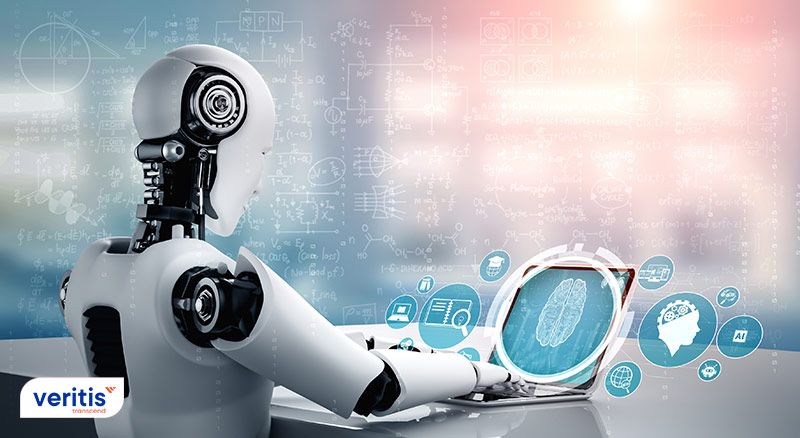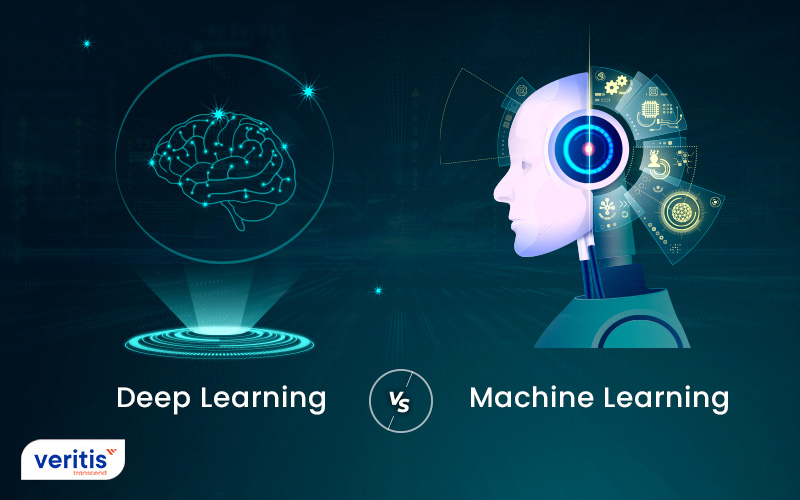
Technologies have become more integrated into our day-to-day operations, and organizations are heavily relying on machine learning (ML) and deep learning (DL) algorithms to stay up with the pace of consumer demands. You can witness its application in social media via object recognition in photographs or directly communicating with the devices like Siri or Alexa.
Machine learning and deep learning concepts have seen ground-breaking developments in the field of artificial intelligence (AI) during the last decade, reshaping the world around us. Businesses are enthralled by the potential opportunities to invest in these emerging technologies, from AI to blockchain. However, both DL and ML are artificial intelligence terms, and their definitions may appear to be interchangeable to newcomers.
Recently, deep learning and machine learning have seen a golden era as these applications have become ubiquitous. In addition, these technologies have become increasingly personalized in our interactions with them. For instance, chatbots can be annoying and still pretty clumsy in their current state, but they are evolving. They have become conversational, learning human characteristics, increasing user experience, and supplementing your customer service approach.
According to the Comet survey, the cloud-based meta machine learning platform, 508 ML practitioners stated that 58 percent respondents are using manual tools to track ML experiments while 47 percent of respondents said that ML teams require 6 months to deploy a single ML project. Moreover, 88 percent of respondents have a budget of less than USD 75,000 for ML tools and infrastructure.
Echoing similar sentiments for deep learning are other surveys. Grand View Research predicted that global deep learning industry market size is estimated to grow USD 526.7 billion at a CGAR of 34.3% over the forecast period by 2030. This technology was projected at USD 34.8 billion in 2021.
Based on the business requirements, your organization can decide which one to implement. Before diving into the crux of the topic, let’s explore the concepts first.
Useful Link: 10 Ways Artificial intelligence (AI) is Transforming DevOps
Deep Learning (DL)

The term deep learning was coined 79 years ago – in 1943, mathematician Walter Pitts and neurophysiologist Warren McCulloch worked together to create a computer-based model. They began to translate neural networks onto computational systems of the human brain.
Deep learning is a subset of the machine learning family, and it comes under the category of artificial intelligence. This technology is a powerful tool that uses three or more layers of neural network algorithms to perform sophisticated computations on a massive amount of data.
It is the most crucial element of data science, including predictive modeling and statistics. DL makes the process easier and faster for data scientists and researchers, who interpret, analyze, and collect a considerable volume of data.
DL model has attracted a lot of attention because it drives many AI services and applications, such as high computing power, improved automation, advancements in data center capabilities, and performing analytical and physical tasks without human intervention. In addition, deep learning algorithms perform routine and repetitive tasks more effectively and quickly than human beings.
Deep learning can be beneficial for real-world applications such as voice-enabled TV remotes, digital assistants, credit card fraud detections and emerging technology such as self-driving cars.
In deep learning, models operate different layers to discover and learn insights from the data. Some best deep learning models are:
- Recurrent Neural Network
- Convolutional Neural Network
- Autoencoders
- Classic Neural Networks and more
How Does Deep Learning Work?
Let’s start with the algorithm’s working principle before moving to the deep learning model. For instance, we all know about neurons in the brain (cells) that capture inputs coming through sensory organs like ears, eyes, etc. When a neuron receives an input signal, it passes the signal through the body and gets activated to produce output. This output will stimulate other neurons to activate so that we can get the complete picture.
Understanding the working of deep learning with the above instance, the deep learning model takes the images as input and feeds them directly to the algorithms without having any manual feature extraction step. The input passes to multiple layers of the AI neural network to estimate the final output.
Machine Learning (ML)

Arthur Samuel coined the term machine learning in 1959 and pioneer of artificial intelligence and computer gaming. Over the few years, the top MNC companies have invested significantly in this technology and left no stone unturned to stay high on top of today’s IT world.
Machine learning is a branch of the artificial family that enables systems to adapt to new data independently and through iterations. It is a process of data analytics that automatically access data and perform tasks through detections and predictions. ML focuses on developing computer programs that can learn data, make decisions, and identify patterns, which involves minimal human intervention.
Machine learning is a member of the artificial intelligence family that aims to create software that can automatically learn from past data to gain knowledge and gradually improve its learning behavior to make the right predictions depending on the new data.
ML is one of the most pivotal and commanding technologies that one would have ever come across. Yet, despite the scope of improvement and investment, developing, maintaining, and training MI models has been ad-hoc and cumbersome. However, transforming machine languages into assistive technology devices is complicated enough to make AI seek help from ML to machines understand as humans do.
Machine learning is a crucial concept for any aspiring data scientist and data analyst and those who wish to transform a bulk amount of raw data into predictions. Both deep learning and machine learning fall under the category of artificial intelligence, and both these models learn from data input.
How Does Machine Learning Work?
Machine learning primarily involves two different approaches, supervised learning, and unsupervised learning.
Useful Link: Top 15 AWS Machine Learning Tools in the Cloud
Supervised Learning
Supervised learning is an algorithm that learns from labeled training data to help machines predict the output. It deals with the unlabelled data. It is a subcategory of machine learning and artificial intelligence.
Unsupervised Learning
Unsupervised learning uses machine learning algorithms to cluster and analyze hidden patterns in input data without regard to output. It allows users to perform more complicated tasks compared to supervised learning. Unsupervised learning algorithms include neural networks, clustering, anomaly detection, and more.
Comparison Between Deep Learning and Machine Learning

Let’s explore the in-depth difference between deep learning and machine learning on different parameters.
| Details | Deep Learning | Machine Learning |
| Model | It is a specialized subset of machine learning. While it comes under the broad category of artificial intelligence | It is a subset of artificial intelligence and a superset of deep learning |
| Data dependency | DL algorithms need a massive volume of data, and users need to feed that vast amount of data for better performance | Even though ML depends on a vast volume of data, it can also manage a smaller amount of data |
| Data representation | Data performed in deep learning is entirely different when compared to machine learning, and it runs neural networks | Data performed in machine learning is wholly different when compared to deep learning, and it runs structured data |
| Number of data points | Deep learning can use thousands of data points to make predictions | Machine learning can use millions of data points to make predictions |
| Execution time | Deep learning usually takes a long execution time to train the model, but it takes less duration to test the model | ML algorithm comparatively takes less time to train the model, but it takes a long duration to test the model |
| Accuracy | It enables faster and more accurate results | It has low accuracy results |
| Performance | It shows better performance on massive datasets | It shows good performance on small and medium-size datasets |
| Hardware dependencies | It works on high-end machines | It works on low-end machines |
| Featurization Process | It requires high-level features from data and develops new features by itself | Needs features to be identified accurately and created by users |
| Output | DL output is usually a numeric value like a score or a classification | ML output has numerous formats such as score, sound, or a text |
| Problem-solving approach | The DL model problem-solving approach is entirely different from the traditional ML model. It takes input and produces the result as it follows the end-to-end approach | The traditional ML model breaks the problem into subfields and after solving each product, it gives the final result |
| Introduced | The term deep learning was coined by mathematician Walter Pitts and neurophysiologist Warren McCulloch in 1943 | Arthur Samuel coined the term machine learning in 1959 |
| Interpretation of result | When we are working with a deep learning model, the interpretation of the result for a given problem is difficult | When we are working with a machine learning model, the interpretation of the result for a given problem is easy |
| Feature Engineering | In deep learning, no need for feature engineering as neural network automatically detects important features | In machine learning, feature engineering is done by humans |
| Type of data | The deep learning model mostly works with structured and unstructured data | Machine learning model work with a structured form of data |
| Suitable for | It is suitable for solving complex problems | It is suitable for solving simple problems |
| Human Intervention | In the deep learning model, it permits to learning features without additional human involvement | In the machine learning model, humans require to identify and hand code the applied features depending on different data types like orientation, shape, pixel value, and more |
| Applications | DL uses in applications such as healthcare, self-driving cars, advanced video game AI, biometrics, and search engines like image search and text search | ML uses in applications such as data analytics, facial recognition, fraud detection, vehicle number plate identification, customer service, finance and banking, and manufacturing |
| Training | It trains on Graphics Processing Unit (GPU) for proper training | It trains on Central Processing Unit (CPU) for proper training |
| Tuning capability | It can be tuned in numerous ways | In ML model, it has the limited tuning capability for hyperparameter |
| Training dataset | Huge volume | Small volume |
| Choose features | No | Yes |
| Number of algorithms | Few | Many |
Useful Link: AWS Launches Graviton3 for Boosting Cryptographic, Machine Learning Workloads!
Download PDF
Conclusion on Deep Learning and Machine Learning
Understanding the latest advances in artificial intelligence (AI) might be daunting. Still, if you only want to master the basics, many AI discoveries can be boiled down to two concepts: deep learning and machine learning. There are numerous examples of deep learning and machine learning, and we can witness them everywhere.
How self-driving cars become a reality, how Netflix predicts which show you’ll like to watch next, and how Facebook detects who is in a photograph. These models seem to be interchangeable buzzwords in the artificial intelligence industry, but they have some key differences.
As a result, deep learning is the way to opt for your business if you have enormous data and powerful technology. Otherwise, implement a machine learning model for your business. As you can witness numerous benefits while opting for both these models, picking the best technology is an arduous task that makes it challenging to pick.
Therefore, instead of having one model, why not implement both the deep learning and machine learning technologies that give you multiple benefits for your business. However, adopting both these technologies is more difficult said than done, which is one of the many reasons why enterprises seek Veritis’ assistance.
Are you looking forward to implementing deep learning or machine learning model in your business? Then Veritis, the Stevie Awards winner, is the right choice to offer digital transformation services for your business. Veritis, the trusted tech partner for Fortune 500 organizations and emerging companies, provides cost-effective solutions without compromising quality.
Explore Digital Transformation Services Consult Our Experts
Additional Resources:
- All You Need to Know about Artificial Intelligence as a Service (AIaaS)
- How AI Adoption Will Transform Your Business
- ITOps vs DevOps vs NoOps Comparison
- AWS vs Azure vs GCP: Cloud Cost Comparison
[WPSM_AC id=14264]